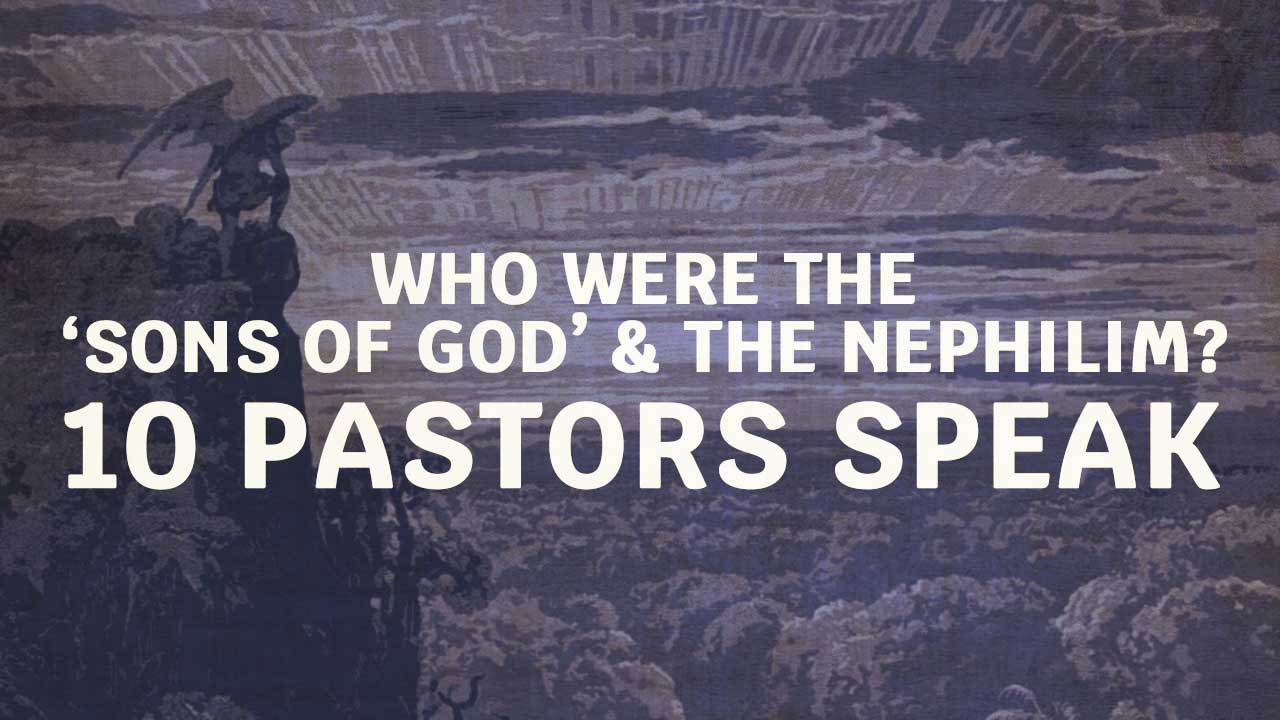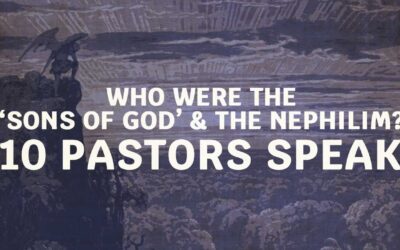Explore COMMENTATORS
A database of modern thought on Genesis 6 from respected scholars & pastors.
ANGEL VIEW
Modern commentators and well-known pastors who interpret the ‘sons of God’ as angels…
Your Title Goes Here
Your content goes here. Edit or remove this text inline or in the module Content settings. You can also style every aspect of this content in the module Design settings and even apply custom CSS to this text in the module Advanced settings.
Al Molher | Angel View | President of The Southern Baptist Theological Seminary
The problem is not that the movie has to fill in any number of narrative gaps, or that Aronofsky used his imagination in so doing.
His oddest characterization, by the way, may well be the “fallen angels” called the “watchers,” based rather loosely on the Nephilim found in Genesis 6:4. They appear in the film as giant figures made of something like rock and asphalt.
They first appear as enemies of humankind, but one, speaking with the voice of Nick Nolte, protects Noah and convinces others to do likewise. They appear as mighty cartoon figures in the movie, but they really belong in a science fiction film.
In portraying the Nephilim this way, Aronofsky has not made these figures more strange than how the Bible describes them.
The Bible actually presents them in even more bizarre terms. They are described as beings who were on the earth in those days, “when the sons of God came in to the daughters of man and bore children to them.”
This appears to be an indication that rebellious angels had sexual intercourse with human women, who bore sons described as “the mighty men who were of old, the men of renown.”
This understanding of the Nephilim seems to be affirmed in the New Testament in Jude, verses 6-7.
Thankfully, this is not the Bible story I was assigned to teach those six-year-old boys many years ago.
Excerpt from – Drowning in Distortion—Darren Aronofsky’s “Noah”
Peter Gentry | Angel View | Professor of Old Testament at the Southern Baptist Theological Seminary
Genesis 6:1-4 is a difficult text… how do we find the right interpretation?
The exact expression, sons of God, only occurs four or five times in the Hebrew Bible.
In the introduction to the book of Job, we see God gathering in His heavenly court,
His heavenly assembly with the angels. The angels are called sons of God there.
There’s another occurrence in the book of Job, Job chapter 38 where God is challenging Job and He says, “Where were you when I created the world?” When He created the world, the sons of God sang for joy.
So it seems to, there it also seems to be a very clear reference to angelic beings.
The last occurrence is in Aramaic in the book of Daniel. When the king looked into the furnace, he saw four people there and it says that one looked like a son of God, which would mean a divine being, an angelic being.
There are only five occurrences in the entire Bible where we have the exact expression, son of God or sons of God and it always refers to angelic beings.
We must distinguish this use from other places. There are other places in the Bible where they indicate that the relationship of a human to God is like a father-son relationship.
So Adam and God have a father-son relationship. In the covenant that God makes with David, God and David have a father-son relationship.
But it doesn’t actually say that Adam is a son of God. It doesn’t use that linguistic expression and it doesn’t say that David is the son of God.
So the only time that linguistic expression occurs in the Bible, it always and very clearly refers to angelic beings.
We also have the, we also have the witness of the New Testament. So there are two passages in the New Testament that refer to this. One is 2 Peter chapter 2 and the other is the book of Jude and both of these texts are very closely related to each other.
In 2 Peter chapter 2, Peter is talking about how difficult days are coming for the Christians and there will be people who deny the faith, who deny the truth about Jesus Christ, the truth about His work, who deny the gospel. There will be false teachers and they will bring corruption into the church and destruction into the church.
What Peter does is he appeals to the Old Testament and he says, well, if God could deliver, if God could deliver His faithful people in difficult times in the Old Testament, then He will be able to do it in the New Testament as well.
Peter refers to two examples in the Old Testament. One is the story of the, of Genesis 6 and Noah and the other is the story of Lot being rescued from the destruction of Sodom and Gomorrah.
And if you look in the Greek text of 2 Peter, it’s very clear that there are two examples and not three examples by the use of the word ‘and’
So there are two examples joined by the word and and each example has two parts, a negative part and a positive part. So, when Peter is talking about the angels who sinned, he’s very clearly talking about Genesis chapter 6 because this is connected with the story of Noah.
Some people say, well, no, he’s not talking about Genesis 6. Well, then my question to them is, if Peter is trying to encourage his readers from well-known stories in the Old Testament and if the angels who sinned is not Genesis 6, then where else is the story? There is no other story in the Old Testament that it could be referring to.
Some people think that it’s the fall of Satan but as we’re going to see when we talk about that, there is no story in the Old Testament that describes the fall of Satan.
Peter is very clearly alluding to Genesis 6. Jude is doing the same thing and it’s very obvious in the book of Jude because he’s talking about people who are false teachers, people who are going to deny the faith and he also appeals to the Old Testament and shows how God delivered His people in the past and He will do so in the future.
He also refers to two events. He refers to angels who abandoned their proper dwelling place, their proper home. He also talks about the cities of Sodom and Gomorrah and he says, since they, in the same way as these committed strange immorality.
Well, in the Greek text, the they refers to the angels and the same way as these, the these refers to the cities of Sodom and Gomorrah.
So what the story of Genesis 6 has in common with the story of Sodom and Gomorrah is that there’s an abnormal form of sexuality going on…
Now, someone might come to me and say, well, Jesus in the gospels says that the angels in heaven neither marry nor are given in marriage. So it’s impossible for an angel to have physical relations with human women.
Well, they’re not reading the gospels accurately and clearly because Jesus is saying that when, in the resurrection, when Jesus returns at the end of history, we, who are resurrected, are not going to marry because we’re going to be like the angels in heaven.
Notice he says the ‘angels in heaven’ and Jude says they ‘left their proper dwelling place’. So there’s no contradiction between Jesus and Jude. In heaven, the angels don’t marry. In Jude, they abandoned their proper dwelling place and they go to commit strange immorality. So there’s no confusion.
So it seems very clear, Genesis 6 is telling us that these are angels who are marrying humans and Jude and Peter are telling us that is the correct interpretation.
Doug Wilson | Angel View | Professor of Old Testament at the Southern Baptist Theological Seminary
The cosmological issues swirling around this topic provide a good case study on how easy it is to get Christians to be embarrassed by certain aspects of Scripture—even if they affirm their belief in technical inerrancy, and even if the text of Scripture is very plain on whatever the embarrassing subject is…
I am arguing here that the Nephilim were the gigantic offspring of an unnatural sexual union between celestial beings (bene elohim) and human women…
There is no reason to resort to the contrived idea that the bene elohim were actually descendants of Seth who apostatized by intermarrying with the daughters of Cain. Elsewhere in Scripture, the phrase bene elohim always refers to celestial beings. And if it had been a merger between the lines of Seth and the line of Cain, why is all the masculinity on one side, and all the women on the other? And why on earth would such unions result in giants? And why would the entire ancient world concur with the reading that this was a perverse celestial/earthly connection, from Josephus to Beowulf to the Book of Enoch—from responsible histories to oddball books? The line of Seth argument doesn’t really come into its own until the modern era—which is precisely when some of these ancient tales began to be a tad embarrassing for us big kids.
William F. Cook | Angel View | Professor of New Testament at Southern Seminary
But in light of examples we see in the New Testament, it seems best to assume that these evil spirits took possession of the bodies of wicked men and used them for their own sinful purposes…
Of course, I may be wrong, and the Sethite interpretation may be correct after all. I certainly grant that the ancient view seems strange to our modern ears. But since Peter and Jude both appear to have held it, it seems to me the best interpretation of Genesis 6:1–4.
Source – The Sons of God in Genesis 6: Sons of Seth, Fallen Angels or Something Else?
Dr. William Lane Craig | Uncertain |
Source – In Jude and 2 Peter we find the sons of God of Genesis 6:1-4 equated with angels along with additional information concerning the angels’ fate which is not inferable from Genesis 6, specifically their being bound by God with chains in the underworld.
Source – There is the suggestion here that some take to mean that demonic, angelic type beings (fallen angels) may have copulated with human females to produce this race of extraordinary men – giants. Or it could have been that they were just ordinary people. It depends on who you think the sons of God are in this. If you think they are demonic creatures or some fallen angels or something that will bear on your interpretation of that. But I don’t think that anybody really knows for sure much about this. It is a source of a lot of speculation.
Source – the pseudepigrapha, which are intertestamental writings or sometimes contemporaneous with the New Testament, which are Jewish writings that aren’t in the Old Testament. They are non-canonical Jewish writings. These can be very, very interesting to give us a kind of insight into the religious thought of people during the day. The Nephilim that you are talking about are these people referred to in Genesis where it says that the sons of God saw that the daughters of men were desirable and they came down and mated with them and sired this race of offspring.
DIG DEEPER
Explore further with respected Biblical scholars and thinkers.
10 POPULAR Pastors & SCHOLARS on the Nephilim and ‘Sons of God’ in Genesis 6
What do popular figures in Christendom like John MacArthur, Al Molher and others believe about the 'sons of God' in Genesis 6? Find out here! In this article, we break down the views of 10 modern conservative Bible commentators and pastors on the mysterious Nephilim...
Who were the ‘Sons of God’ in Genesis 6?
Everything you need to know about the historical, textual and theological evidence pointing to the true identify of the ‘sons of God’ in Genesis 6.
Why We Need Systematic Biblical Nephilology
Confronting “un-biblical neo-theo sci-fi tall-tales” Ken Ammi’s critical analysis encourages a fresh perspective on the ancient accounts, offering a more nuanced understanding of the biblical Nephilim phenomenon.













John Piper’s Ministry tackles the Divine Council & the ‘Sons of God’
Kaspars Ozolins - a research associate at Tyndale House in Old Testament and the Ancient Near East - writes for John Piper's website a fairly detailed look at the concept of the "divine council" and the "sons of God" in his article for Desiring God.
In "The Divine Council," Ozolins tackles the references to heavenly beings scattered throughout the Old Testament, helping to distinguish the biblical concept from the pantheon-driven mythology of the ancient Near East.
Author: Kaspars Ozolins
Interpretation: Angel
Short Excerpt: The phrase occurs in key passages in Scripture, most notably in Genesis 6 and Job 1–2, as well as in a number of psalms. According to Genesis 6, one precursor for the flood was the intermarriage of the “sons of God” with the “daughters of men.” Although the understanding of this passage is difficult, it seems likely, when taking into account the references to this passage in Jude and 2 Peter, that “sons of God” here refers not to men from the godly line of Seth, but rather to fallen spiritual beings. Thus, Jude 6 and 2 Peter 2:4 appear to be describing the unnatural union of fallen angels and humans.